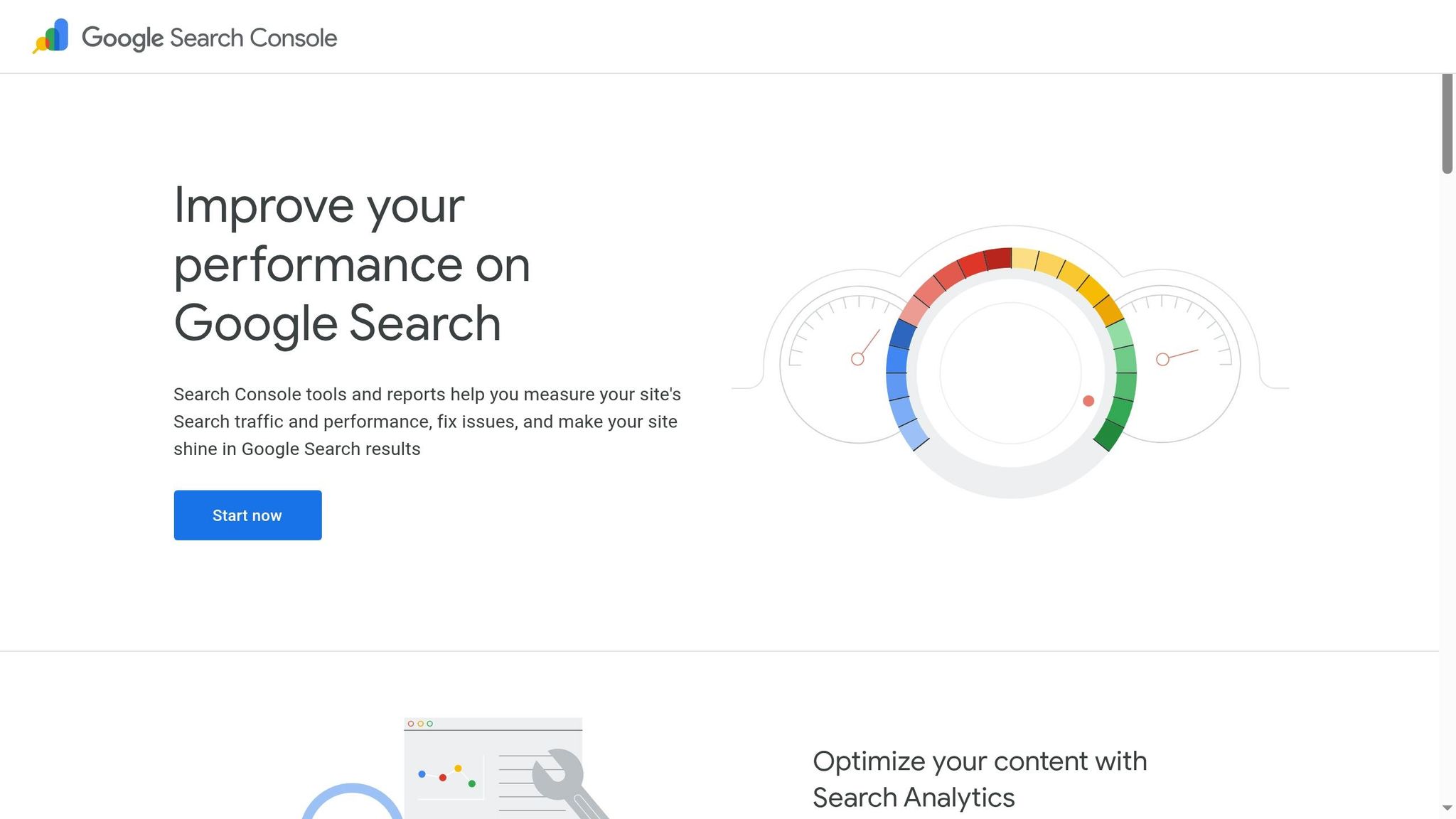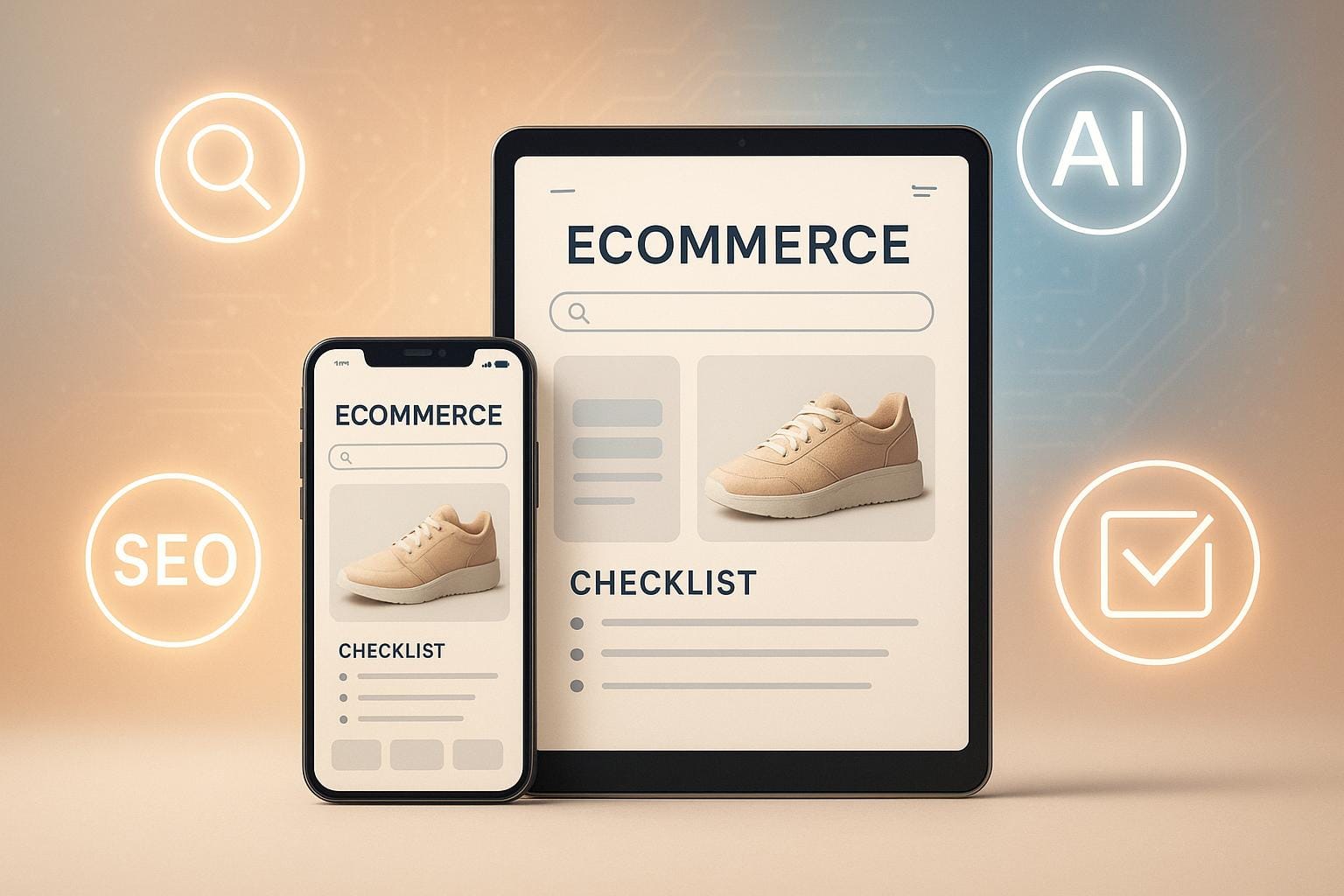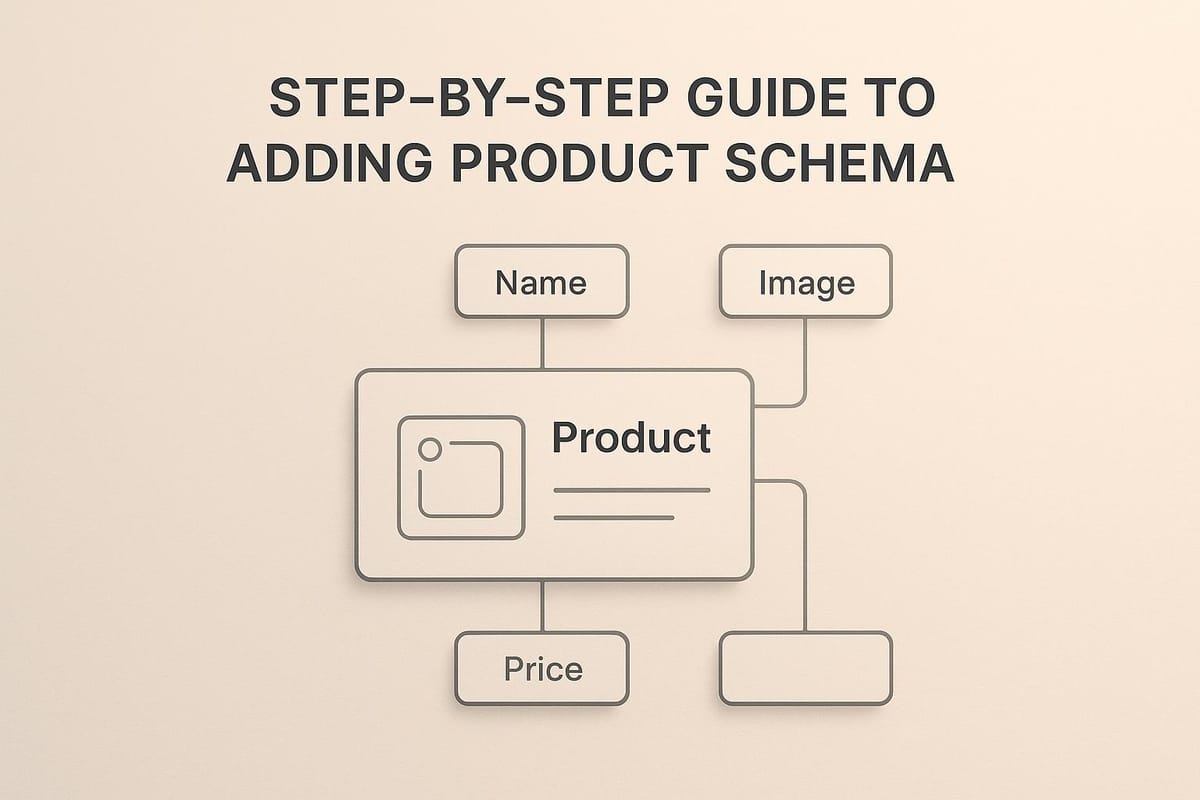Staying visible in 2025’s ecommerce landscape means adapting to AI-driven search engines, mobile-first designs, and evolving customer behaviours. This checklist breaks down the essentials:
- Site Performance: Fast-loading pages (under 1 second) are critical. Use Core Web Vitals benchmarks like LCP (<2.5 seconds), INP (<200ms), and CLS (<0.1).
- Mobile Optimisation: With mobile traffic dominating (59%), ensure responsive design, touch-friendly navigation, and HTTPS for secure browsing.
- Keyword Research: Focus on transactional, long-tail, and UK-specific terms (e.g., "trainers" not "sneakers"). Include seasonal and local intent keywords.
- Product Pages: Write concise, keyword-rich titles and unique descriptions. Use high-quality images with alt text, product schema, and customer reviews to improve rankings and conversions.
- Voice Search: Optimise for natural, question-based queries and featured snippets.
- AI-Driven Search: Create in-depth content that aligns with user intent and covers related terms.
- Accessibility: Add alt text, ensure keyboard navigation, and maintain clear heading structures.
- Tools & Analytics: Use Google Search Console and SEMrush to monitor rankings, fix technical issues, and identify opportunities.
7-Step Ecommerce SEO Checklist (2025)
Technical SEO Basics
Getting the technical details right is the backbone of ecommerce SEO. These essentials ensure search engines can crawl, index, and rank your store effectively while providing the fast, secure experience shoppers expect.
Site Speed and Performance
Page speed is a game-changer: pages that load in under 1 second can triple conversion rates, while 53% of mobile users abandon sites that take over 3 seconds to load. For UK ecommerce sites competing in a crowded market, every millisecond matters.
Core Web Vitals are now critical ranking factors, focusing on real user experience. Aim for these benchmarks: Largest Contentful Paint (LCP) under 2.5 seconds, Interaction to Next Paint (INP) under 200 milliseconds, and Cumulative Layout Shift (CLS) below 0.1.
Image optimisation is a must for better performance. Compress images, switch to modern formats like WebP, and use lazy loading to reduce initial load times.
Browser caching speeds up repeat visits by storing static elements - like CSS, JavaScript, and images - locally. Set your server to cache these files for around 30 days to improve loading times for returning users.
Content Delivery Networks (CDNs) spread your site’s content across multiple servers, cutting down latency based on a user’s location. For UK retailers, a CDN ensures visitors from all over the country experience consistently fast load times.
Code minification cleans up your HTML, CSS, and JavaScript files by removing unnecessary characters, comments, and spaces. While individual savings may seem small, they add up across your site. Many hosting providers and plugins now automate this process.
These steps not only improve desktop performance but also lay the groundwork for a smoother mobile experience.
Mobile-Friendly and Secure Websites
Beyond speed, having a mobile-friendly and secure site is non-negotiable. Mobile traffic dominates ecommerce, making up 59% of all traffic, with 79% of shoppers using their smartphones to browse. Your mobile experience directly impacts your success.
Google's mobile-first indexing prioritises your mobile site when determining rankings. If your mobile version lacks the content or features of your desktop site, your rankings could take a hit.
Responsive design is key - it ensures your site adapts to various screen sizes. This means considering mobile user habits, touch interactions, and simplified navigation.
The viewport meta tag (<meta name="viewport" content="width=device-width, initial-scale=1.0">) ensures your pages display correctly on all devices, making your site accessible to users on any screen size.
Touch-friendly design is essential. Buttons and links should be at least 44x44 pixels, with enough space to avoid accidental clicks. Think about how users will browse categories, add items to their basket, and check out - all with their thumbs.
HTTPS with SSL certificates is a must for safeguarding customer data and improving rankings. Many hosting providers now offer free SSL certificates, making this an easy win for ecommerce businesses.
The numbers don’t lie: 74% of users are more likely to return to mobile-friendly websites, and 68% of businesses report increased sales after prioritising mobile-first design. These aren't just technical tweaks - they're essential for staying competitive in today’s ecommerce landscape.
Keyword Research for Ecommerce
Once you’ve got your site’s technical setup in place, the next step is targeted keyword research. This is what helps bring in the right kind of traffic to make your ecommerce business thrive. Unlike general content marketing, ecommerce keyword research is all about attracting shoppers at various stages of their buying journey - whether they’re just starting to browse or ready to hit "buy now."
Finding Transactional and Long-Tail Keywords
Transactional keywords are gold for ecommerce. These are the terms people use when they’re ready to make a purchase - words like "buy", "order", "shop", or "purchase." They’re high-conversion keywords because they signal immediate buying intent.
Commercial investigation keywords catch shoppers in the research phase. Think phrases like "best running shoes 2025", "iPhone vs Samsung comparison", or "cheap laptops under £500." While these users are still deciding, they often convert well once they land on your product pages. Plus, these keywords tend to have less competition.
Long-tail keywords are your secret weapon against the big players. For instance, instead of targeting "running shoes" (where major brands dominate), go for something like "waterproof trail running shoes for women UK." These more specific searches attract highly targeted traffic and are easier to rank for.
Product-specific long-tail variations help you zero in on buyers who know exactly what they want. Instead of targeting generic terms like "laptop", aim for "15-inch gaming laptop under £800" or "lightweight laptop for students." These searches have less competition and higher conversion rates.
Seasonal and trending modifiers can expand your keyword list. Adding phrases like "2025", "new", "latest", "Christmas", or "Black Friday" to your product keywords helps you tap into time-sensitive searches that often lead to quick sales.
Local intent keywords are essential even for online stores. Phrases like "UK delivery", "next day delivery London", or "British made" help you compete with global retailers while appealing to shoppers looking for local options.
Using Tools for Keyword Research
There are plenty of tools to make your keyword research more effective:
- Google Search Console: This tool is a treasure trove of data on how people find your site. The Performance report can highlight queries where you rank on pages two or three - these are great opportunities for quick optimisation wins.
- SEMrush: Ideal for competitive analysis, it helps you discover new keyword opportunities. Use the Keyword Magic Tool to explore variations of your keywords and the Organic Research feature to see what’s driving traffic to your competitors.
- Google’s autocomplete and "People also ask": These free tools give you insight into real search behaviour. Simply start typing your product categories and see what Google suggests - it’s a quick way to find popular searches.
- Amazon’s search suggestions: Since Amazon prioritises commercial searches, its autocomplete feature is perfect for finding ecommerce-specific keywords.
- Search volume vs competition balance: Focus on keywords with decent traffic (100-500 monthly searches) and manageable competition. High-volume keywords are tempting but often too competitive, while long-tail terms usually convert better.
- Search intent analysis: Look at the top-ranking pages for your target keywords. If they’re mostly category pages, your product page might struggle to rank. If they’re blog posts, you might need to create informational content instead.
UK-Specific Keyword Research
When targeting British shoppers, it’s important to tailor your keyword strategy to reflect local preferences and behaviours.
British terminology is key. UK shoppers search for "trainers" instead of "sneakers", "jumpers" instead of "sweaters", and "mobile phones" rather than "cell phones." Using American terms can cost you valuable traffic.
Seasonal patterns in the UK create unique opportunities. For instance, "Back to school" peaks in late August and early September, while "Boxing Day sales" on 26th December often surpass Black Friday in search volume. Keywords tied to these events can drive significant traffic.
Regional variations also play a role. Scottish shoppers might search for terms like "Scottish delivery", while those in Northern Ireland could include "Northern Ireland delivery." Adding these location-specific modifiers can help you capture more targeted traffic.
Currency and measurement considerations matter too. Use "£", "pounds", "UK sizes", and metric measurements. Shoppers searching for "size 8 UK" or "under £50" are specifically looking for UK-relevant results.
British spelling conventions can influence search behaviour. Words like "colour" (instead of "color") and "realise" (instead of "realize") might seem minor, but they can improve your relevance for UK audiences.
Local competitor analysis is another way to uncover opportunities. Tools like SEMrush can show you which keywords drive traffic to successful UK-based competitors, helping you refine your strategy.
Seasonal and cultural events unique to the UK also provide keyword opportunities. Events like "Wimbledon", "Royal Ascot", "Glastonbury", and "Edinburgh Festival" often drive searches for related products. Don’t forget time-sensitive events like "Mother’s Day UK" and "Father’s Day UK", which differ from their US counterparts.
Product Page Optimisation
Once you've tackled your site's technical upgrades, the next step is to focus on creating product pages that convert visitors into buyers. These pages are where search traffic meets sales, so they need to strike a balance between what search engines prioritise and what shoppers need to confidently click "add to basket."
Writing Better Titles and Descriptions
Product titles need to do double duty, appealing to both search engines and potential buyers. A strong title should include the brand, product name, key features, and any relevant details like model numbers or sizes. For instance: "Nike Air Zoom Pegasus 40 Men's Running Trainers - UK Size 9 - Black/White" clearly communicates all the essentials.
Keep your titles concise - ideally within 50–60 characters - to ensure they display properly in search results. Pair this with meta descriptions of around 155 characters that highlight key details, include your primary keyword, and encourage action. For example: "Shop Nike Air Zoom Pegasus 40 trainers from £89.99. Free UK delivery on orders over £50. Lightweight design with responsive cushioning. Order now."
Every product page should have unique content. Even for similar items, avoid duplicate titles and descriptions. Search engines penalise repetition, and customers need clear distinctions. If you're selling the same trainer in multiple colours, make sure each variation has a tailored title and description that emphasises its specific colour.
Place keywords naturally in your titles and meta descriptions. The main keyword should appear early in the title and at least once in the description. However, avoid overloading your content with keywords - modern algorithms are smart enough to understand context and related terms.
Once your titles and descriptions are optimised, focus on enhancing the rest of the product page with detailed content and high-quality visuals.
Improving Content and Images
Your product descriptions should go beyond just listing features - they need to help shoppers imagine using the product. Write with your customers in mind first, then optimise for search engines. Include all the relevant details: dimensions, materials, care instructions, and compatibility. For example, a laptop description should cover screen size, processor type, RAM, storage capacity, and battery life. For clothing, mention fabric composition, fit, and sizing.
To make your content easy to read, structure it well. Use short paragraphs, bullet points for key features, and subheadings to break up longer sections. This not only helps shoppers quickly find the information they need but also makes your page more search-engine friendly.
Incorporate internal links in your product descriptions to guide customers to related items or helpful resources. For instance, you could link to complementary products, size guides, or blog posts with styling tips.
When it comes to visuals, image optimisation is key. Use high-quality photos that load quickly. Show the product from multiple angles, include close-ups of details, and add lifestyle shots that showcase the product in use. To further enhance accessibility and SEO, use descriptive alt text for each image. Instead of cramming in keywords, describe the image accurately. For instance: "Nike Air Zoom Pegasus 40 in black and white, side view showing mesh upper and rubber sole."
Adding videos can also elevate your product page. Keep demonstration or unboxing videos short - under two minutes - and ensure they're mobile-friendly.
Adding Structured Data and Reviews
Implementing schema markup allows search engines to better understand your product information, which can lead to enhanced search result snippets. Use product schema to include details like the product name, description, price, availability, brand, and review ratings. This can result in your product appearing in search results with star ratings, price information, and stock status.
For UK ecommerce sites, price markup is particularly important. Ensure your schema uses GBP (£) and displays prices correctly (e.g., £89.99). Accurate availability details also help platforms like Google Shopping display the right information about your products.
Review schema can make your search listings more eye-catching by showing star ratings and review counts. By adding this, you can attract more clicks from search results.
Another useful addition is breadcrumb markup, which helps search engines understand your site's structure. This can improve your search snippets by showing a navigation path like "Home > Men's Trainers > Running Shoes > Nike Air Zoom Pegasus 40", rather than just your domain name.
Customer reviews are invaluable for both SEO and building buyer confidence. They provide fresh, user-generated content that search engines favour and act as social proof for potential buyers. Encourage customers to leave reviews by following up with an email after delivery, offering small incentives, or making the review process simple.
When it comes to review management, responding to feedback is crucial. Thank customers for positive reviews and address concerns raised in negative ones. This shows that you're committed to customer satisfaction and helps build trust with future buyers.
Finally, make sure reviews are prominently displayed on your product pages. Show the overall rating, the total number of reviews, and highlight recent ones. Including customer photos can further boost confidence and increase conversion rates.
SEO Tools and Analytics
Once your product pages are optimised, the next step is to monitor their performance and refine your strategy. Analytics tools are essential for understanding what’s working and where improvements are needed. Here's how you can use them to boost your ecommerce site.
Setting Up Google Search Console

Google Search Console is an indispensable tool for understanding how Google interacts with your website. It provides insights into indexed pages, search appearances, and technical issues that may be holding you back.
To get started, verify your site using an HTML file or meta tag, then upload your XML sitemap. This helps Google index your product pages more efficiently.
The Performance report is a goldmine of information. It shows which search queries bring visitors to your site, alongside data like average position, impressions, and click-through rates. For ecommerce, focus on product-related queries. If certain keywords have high impressions but low clicks, it’s time to revisit your meta descriptions.
The Coverage report helps you identify and fix indexing issues. Common problems for ecommerce sites include duplicate content, blocked pages in robots.txt, or server errors during peak traffic. Google provides specific guidance for resolving these, so tackle them systematically.
Pay attention to the Core Web Vitals report, which highlights pages with performance issues. Poor scores here can hurt your rankings, so prioritise fixing these, especially for high-traffic product categories.
The Mobile Usability report is crucial, given that most online shopping happens on mobile devices. Any issues flagged here should be addressed immediately to avoid losing potential customers.
Finally, enable email alerts for new issues. This is especially useful during busy shopping periods when technical problems can impact your revenue significantly.
While Google Search Console gives you direct insights from Google, pairing it with a tool like SEMrush can provide a broader view of your competitive landscape.
Using SEMrush for Analysis

SEMrush is a powerful tool for tracking your SEO progress and analysing competitors.
The Position Tracking tool monitors keyword rankings over time, helping you measure the impact of your optimisation efforts. Set up a project for your domain and track your most important product keywords weekly to spot trends and seasonal shifts.
Use the Site Audit feature to identify technical SEO issues across your site. It flags problems like broken links, slow-loading pages, missing alt text, and duplicate content. For ecommerce, focus on issues affecting product pages, as these can directly influence sales.
The Keyword Gap analysis is invaluable for finding opportunities. It shows keywords your competitors rank for but you don’t. For instance, if a competitor ranks well for "organic cotton bedding" and you sell similar items, this could be a keyword worth targeting.
With the Backlink Analytics tool, you can review your link profile and identify opportunities for improvement. Analyse the types of sites linking to your competitors - such as industry blogs or directories - and develop strategies to earn similar links.
The Traffic Analytics feature estimates your competitors’ organic traffic and highlights their top-performing pages. This can uncover successful product categories or content ideas to consider for your own site.
Automate your reporting with SEMrush to track progress each month. Include metrics like organic traffic growth, keyword ranking changes, and resolved technical issues. These reports not only help you measure success but also guide your future SEO plans.
Making Data-Driven Improvements
Regularly analysing your SEO data is key to setting priorities and making informed decisions.
Combine data from multiple tools for a complete picture. For example, if Google Search Console shows declining impressions for a product category, check SEMrush to see if competitors are ranking higher for those keywords. Then, cross-reference this with your sales data to assess the business impact.
Seasonal trends are especially important for ecommerce. Monitor how rankings and traffic fluctuate around holidays, sales events, or seasonal launches. Use this data to plan your content calendar and optimise your site ahead of peak periods.
Export data on your top 100 organic pages from Search Console, analyse what’s working, and apply those insights to underperforming pages.
Set up conversion tracking in Google Analytics to connect your SEO efforts to actual sales. Focus on keywords that drive revenue, not just traffic.
Experiment with A/B testing to refine your strategy. For example, test different title tags, meta descriptions, or product page layouts to see what improves click-through rates and conversions.
Create monthly SEO reports that emphasise business outcomes. Highlight metrics like organic revenue growth, improved conversion rates, and the value of new keyword opportunities. This approach helps stakeholders see the tangible benefits of investing in SEO.
Finally, keep an eye on competitors. Set alerts for changes like new product launches, site updates, or significant ranking improvements. Reacting quickly to these changes can help protect your market share and keep you competitive.
New Trends and Advanced Methods
Technical upgrades and smarter content strategies are key to keeping your ecommerce site competitive and easy to use in 2025. As search engines evolve and customer habits shift, adopting new SEO techniques can help your site stand out in a crowded market.
Voice Search Optimisation
Voice search is changing the way people shop online. With more UK households using smart speakers and voice assistants, optimising for spoken queries is essential.
Voice searches are usually longer and more specific than typed ones. For example, instead of typing "running shoes", someone might ask, "What are the best running shoes for flat feet under £100?" To adapt, focus on question-based keywords. Tools like AnswerThePublic can help identify common questions in your niche. If you sell kitchen appliances, you might target phrases like "how much does a good stand mixer cost" or "which blender is best for smoothies?"
Featured snippets play a big role in voice search. Create content that answers specific questions clearly and concisely. For example, use headings such as "What makes this product special?" or "Who is this product best for?" in your product descriptions or FAQs to increase your chances of being featured.
For voice searches with local intent, develop location-specific content. Phrases like "furniture stores near me" or "same-day delivery in Manchester" are increasingly popular. Include relevant local details, such as postcodes or nearby landmarks, in your product descriptions.
Finally, ensure your content has a conversational tone. Write descriptions that sound natural when spoken aloud. These strategies also tie into the next big trend: AI-driven search.
Working with AI-Driven Search
Search engines now rely heavily on artificial intelligence to understand user intent and assess content quality. Outdated practices like keyword stuffing are not only ineffective but can harm your rankings.
Instead, focus on creating content that demonstrates depth and expertise. For example, if you sell cameras, go beyond listing specs. Explain what those features mean in practical terms, share usage tips, and address common concerns.
Organise your content around topic clusters rather than isolated keywords. If you sell outdoor gear, build comprehensive guides like "winter hiking essentials", naturally weaving in related products and terms. This helps AI recognise the breadth of your knowledge.
User engagement signals - like the time visitors spend on your site - are becoming more influential in rankings. Encourage engagement by offering detailed size guides, related product suggestions, and customer photos, all of which help shoppers make informed decisions.
AI also understands semantic relationships between words. For example, a search for "eco-friendly cleaning products" might also connect to terms like "biodegradable", "non-toxic", or "recyclable packaging". Use a variety of related terms in your product descriptions to enrich your content without over-repeating keywords.
To align with AI-driven search, aim to cover the entire customer journey in your content. Include everything from basic product features to advanced tips, such as care instructions, compatibility details, and troubleshooting advice.
Better Accessibility and Usability
Improving accessibility and usability not only enhances the customer experience but also boosts your site's SEO performance. Search engines reward sites that are user-friendly for everyone.
Start with alt text for images, which helps screen readers and provides additional keyword context for search engines. Ensure your site supports keyboard navigation, allowing users to browse, add items to their cart, and check out without a mouse.
Pay attention to colour contrast to ensure text and important elements are easy to read, especially for users with visual impairments. Use tools like WebAIM’s contrast checker to verify your design meets accessibility standards.
A clear heading structure benefits both users and search engines. Use H1 tags for product names, H2 for main features, and H3 for detailed specifications. This makes your content easier to navigate and understand.
Replace generic phrases like "click here" with descriptive link text. For instance, use "view customer reviews for this product" or "check delivery options for your area" to provide more context.
Loading speed is critical, especially for users on slower connections or older devices. Compress images, streamline your code, and consider lazy loading for image-heavy pages. A faster site not only ranks better but also converts more visitors into buyers.
Since most ecommerce traffic comes from mobile devices, mobile accessibility should be a top priority. Ensure buttons are large enough for touch navigation, text is easy to read without zooming, and forms work seamlessly on smaller screens.
Finally, think about adding voice navigation for users who can't use traditional input methods. This emerging technology not only supports accessibility but also gives you an edge in catering to diverse customer needs.
Conclusion
Succeeding in ecommerce SEO in 2025 means crafting a strategy that blends technical accuracy with content designed for real users. The checklist we've discussed acts as a clear guide to boosting your search rankings and attracting more organic traffic to your store.
Start with the basics: ensure your site performs well, is optimised for mobile, and offers seamless navigation free from errors. These elements set the stage for your content and products to shine.
When it comes to keywords, focus on transactional and long-tail phrases that align with UK search habits. Include location-specific terms and reflect the unique language preferences of your audience. This foundation directly impacts how well your product pages rank in search results.
From there, make sure your product pages are built to engage and convert visitors. Use compelling titles, detailed descriptions, and high-quality images with proper alt text. Add structured data markup for better visibility, and leverage customer reviews and user-generated content to build trust - search engines and shoppers alike value this authenticity.
Keep refining your approach using data. Tools like Google Search Console and SEMrush provide valuable insights to help you track progress, uncover new opportunities, and fine-tune your strategy. Regularly monitoring your site ensures you catch potential issues early, before they affect your rankings.
Looking ahead, stay tuned to ongoing shifts in SEO. Trends like voice search optimisation, AI-influenced search behaviour, and accessibility enhancements are already shaping how sites rank and how customers interact with them. Adapting to these changes now keeps your site competitive as technology evolves.
Tackle improvements step by step. Focus first on areas that can deliver the biggest gains - whether that’s resolving technical problems, enhancing your top-performing product pages, or closing accessibility gaps. Each improvement you make strengthens your overall SEO framework for 2025, building a solid foundation for long-term success.
FAQs
What are the best ways to optimise my ecommerce site for AI-driven search in 2025?
To prepare your ecommerce site for AI-driven search in 2025, start by focusing on creating content that puts users first. Make sure it’s well-organised and enhanced with semantic markup to improve clarity and structure. Use tools like generative AI and Large Language Models (LLMs) to craft content that’s not only relevant but also rich in context.
Adding structured data is another key step. This helps search engines interpret your site more effectively. Also, optimise for voice search by incorporating natural language and addressing common customer questions directly. By aligning your content with user intent, you’ll ensure it meets the expectations of both users and AI-powered search engines.
Finally, keep an eye on your site’s performance. Tools like Google Search Console can provide valuable insights, helping you stay ahead in the ever-changing landscape of AI-driven search.
How is optimising for voice search in ecommerce different from traditional SEO?
When it comes to search engine optimisation, the traditional approach revolves around specific keywords, fine-tuning technical SEO, and integrating structured data to perform well in typed search queries. On the other hand, voice search optimisation takes a different route, focusing on natural, conversational language and long-tail, question-based phrases that align with how people speak.
Voice searches often highlight local intent and aim to provide quick, straightforward answers. This means ecommerce sites need to adjust their content to match natural speech patterns and user intent. While traditional SEO prioritises keyword accuracy and technical efficiency, voice search requires a more user-centred and context-driven strategy to stay relevant.
Why is it important to target UK-specific keywords for ecommerce SEO, and how can I find them?
Targeting UK-specific keywords is a smart move if you want your ecommerce site to stand out in local search results. Why? It boosts your visibility to UK consumers who are more likely to engage with your content and, ultimately, make a purchase. Plus, tailoring your content to match local spelling, language, and cultural preferences helps establish trust and relevance with your audience.
To find these keywords, tools like Google Keyword Planner or SEMrush can be incredibly useful for analysing local search trends. Focus on long-tail keywords - these tend to have lower competition and better reflect UK consumer habits and language. Don't forget to include regional phrases, popular product terms, and seasonal keywords that resonate with UK shoppers. These small adjustments can make a big difference in fine-tuning your strategy.




Comments